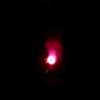good, with a end burner( i presume thats what your using) your not going to create a lot of thrust, but you'll have a longer duration of flight( = greater height under no load).I launched a couple tonight, one with a 1" payload and one with a 2"payload.
The one inch worked perfectly, right height, burst at apogee.
The 2" went about 60 feet then fipped upside down and hit the ground under power then burst.
I am getting there though
so to lift a heavier payload , ie a three inch shell atop a 18mm motor, your going to need thrust by burning more fuel per meter/second.
how is this achieved i hear you say, well its down to motor design at the moment with the end burner configuration, only a small surface area of the propellant is able to burn, ie the "end!" which say is 18mm, has a surface area of 254 mm(squared).
so to get more thrust we need to change the motors internal geometry, by creation of a hollow core.
this now allows us to achieve a greater surface area of propellant, well use a cylindrical core for a example , a 9mm dia x 175mm high core will have a surface area of 496mm (squared)and the area will keep expanding as the propellant is used= more fuel burnt per sec.
i think lol
















